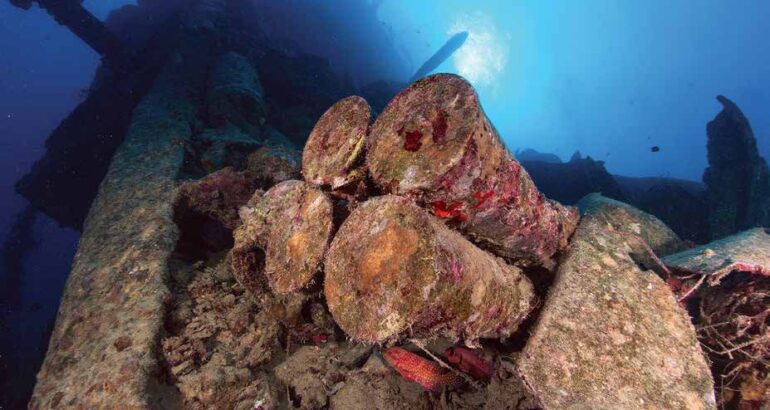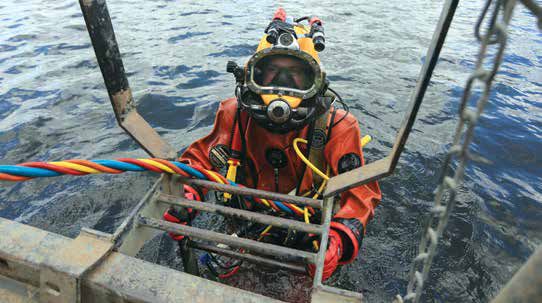By Ryan Prophet, Rhiannon Davies and Henry Welling
Beneath the ocean’s surface lie unknown mysteries and dormant beasts—entities that can destroy your construction project should you have the misfortune to encounter them. You may be imagining legendary sea monsters, but this threat is real and commonplace. We’re talking about unexploded ordnance (UXO). WWUXO is a term that encompasses both accidental remnants of war and dumped or abandoned munitions. In Europe, much of the contamination dates back to World War II, but more recent conflicts have spread the problem to other parts of the world. Today, UXO drifts in our oceans and litters the seabed, posing a costly risk to marine construction projects and a potentially lethal threat to workers.

How dangerous is UXO in the marine environment?
Ordnance in the marine environment becomes increasingly unstable with each passing year. Prolonged exposure to seawater can increase the sensitivity of explosive material to detonation. Also, many World-War-era sea-dumped munitions are approaching a corrosion threshold, beyond which hulls will become breached and explosive material exposed.
It only takes one corner to be cut or one aspect of a project’s plan to be overlooked for an unexpected UXO encounter to occur. Such an encounter can bring dire reputational and financial consequences, and even the loss of life:
- In January 2021, a vessel in the North Sea encountered WWII ordnance that detonated beneath the hull, critically injuring crew.
- Over 50 million items of UXO litter the North and Baltic Sea floors. Fishermen and offshore workers regularly encounter rusted shells containing chemical contaminants and lethal gases. Injuries are common.
- In October 2020, naval forces attempted to deflagrate a 6-meter, 5.4-tonne World War II “Tallboy” bomb. The deflagration process was unsuccessful and accidental detonation occurred. The impact was felt miles away.
The threat is global, serious, and in the case of older ordnance, increasing.
Mitigation response creates cost savings and health and safety uplift
Survey technologies and clearance methodologies are improving at pace in line with the increasing threat, allowing for faster, more accurate target identification, environmentally conscientious clearance and the reduction of overall risk. With application of the most appropriate survey methodology, which will depend on a specific project’s location, the threat level and the potential UXO (pUXO) that could be encountered, disruption to your project can be minimized or entirely negated. Budgets will be protected and timelines maintained.
Protecting marine construction projects from the multiple risks posed by UXO
UXO risk potential can be identified initially via a desktop survey. This consists of the analysis of historical and anecdotal data to determine the level of threat within your planned project area. Subsequently, depending on the results of the survey, non-intrusive surveys can be carried out in any medium to high-risk area.
High-resolution survey data can be obtained without large, dynamic positioning vessels, potentially via the cross-utilization of your current assets, saving you money. By combining multiple adaptive technologies in a single sweep, a multitude of data sets can be obtained simultaneously.
SafeLane Global is one company pioneering this approach. It has developed proprietary systems that collect and combine acoustic sonar, sub-bottom, and magnetometer results to increase the accuracy of anomaly characterisation. Their solution can be used in deep or shallow water, offshore, nearshore, and inshore making it entirely adaptive to meet your project’s entire requirements.
This approach reduces the number of anomalies needing inspection by an average of 70 percent, creating a health and safety uplift as diver time in the water is reduced accordingly. Where potential UXO is identified, far greater detail about any object is provided to a clearance diver before they enter the water, reducing the time in the water a diver needs to confirm identification.
Low-order deflagration to safely dispose of marine UXO
For some marine construction projects, the identification of ordnance results in the re-routing of a cable or the repositioning of a foundation to simply avoid the threat. However, sometimes avoidance is not possible. If ordnance needs to be disposed of, the best approach for the fragile marine environment is low-order deflagration.
Deflagration is the preferred alternative to detonation, stopping large vibrations that may cause damage to marine life. It converts explosives into gas, heat and shock. Detonation is not always avoidable, however, especially when dealing with unstable explosive devices. In situations like these, SafeLane Global utilizes solutions that include bubble curtains and acoustic deterrents to keep marine life away from a controlled detonation.
Underwater bomb disposal by an unnamed company in November 2020 caused the deafening and death of eight porpoises, solely because the above precautions were not taken. Similar situations have occurred worldwide, such as the stranding of 39 long-finned pilot whales in Scotland due to the use of detonation rather than deflagration.
Underwriting your explosive event risk
A final costly consideration marine constructors need to contemplate is insuring their explosive event risk. Associated costs can cripple a project’s profitability if not factored in at the outset. Some unexploded ordnance threat mitigation organizations will underwrite this risk for you, as part of their comprehensive solution.
De-risk your marine construction project—mitigate the UXO threat
Encountering unexploded ordnance is unlikely, but it is possible, and it does happen. When unplanned, an encounter can result in loss of life, serious injury, financial loss, reputational damage and/or project delay. De-risk your marine construction project by mitigating UXO threats.
For more information about UXO risks and SafeLane Global Ltd., please visit www.safelaneglobal.com n
Ryan Prophet is the marine director at SafeLane Global Ltd., which is located in Gillingham, Kent, England
Republished from Marine Construction Magazine Issue V, 2022










